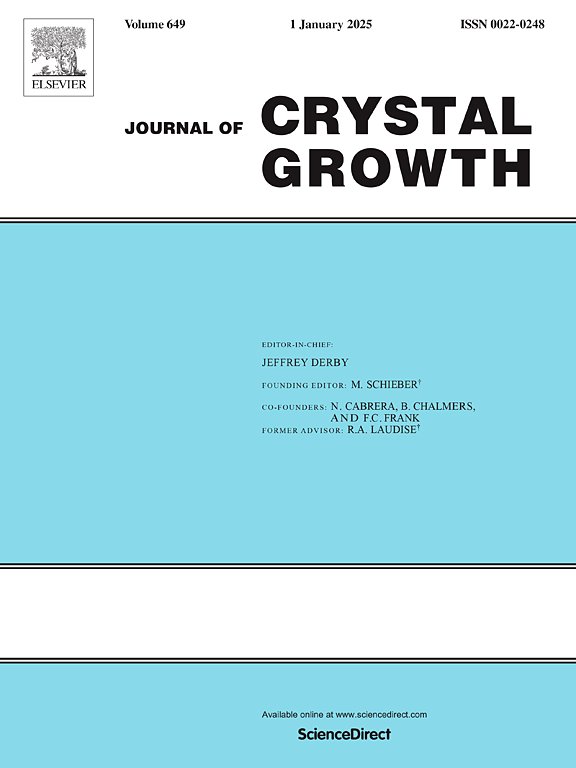使用三甲基镓和 H2O 的热原子层沉积 Ga2O3 薄膜
IF 1.7
4区 材料科学
Q3 CRYSTALLOGRAPHY
引用次数: 0
摘要
原子层沉积(ALD)技术被认为是制造高质量 Ga2O3 薄膜的有效方法。三甲基镓(TMG)在室温下具有很高的蒸气压(227 托),被广泛用作该技术中的镓前驱体。对于氧前驱体,常见的选择包括 O3 和 O2 等离子体。然而,在热原子层沉积(TALD)过程中,H2O 作为氧前驱体对 Ga2O3 薄膜的影响仍未得到充分探讨。本研究调查了以 TMG 和 H2O 为前驱体在蓝宝石基底上沉积的 Ga2O3 薄膜在 250-500 °C 温度范围内的温度窗口和生长特性。在 250 ℃ 时,沉积的 Ga2O3 薄膜呈现无定形结构,而在 300 ℃ 至 500 ℃ 的基底温度范围内,它们过渡到 α 相。半峰宽(FWHM)随着温度的升高而变窄,在 500 ℃ 时,(0006) 面的特征峰向更高的角度移动。STEM 分析表明,α-Ga2O3 薄膜与蓝宝石基底之间具有完全的一致性,表明形成了假晶结构。450 °C 时薄膜的生长速率为 0.083 Å/周期。用 H2O 作为氧前驱体制备的 Ga2O3 薄膜具有富镓特性,在 250 ℃ 至 500 ℃ 的温度范围内,(Ga + Al)/O 原子比介于 0.88 和 0.91 之间。薄膜的粗糙度(Ra)在 0.453 至 0.646 nm 之间。在 400-500 °C 温度范围内,薄膜表面形成岛状颗粒,随着温度的升高,颗粒变得平滑。薄膜的带隙在 450 °C 时达到峰值 5.50 eV。TMG 与蓝宝石衬底上的 H2O 反应会产生 Ga2O3 薄膜和 CH4 副产品,这与三甲基铝过程类似。本文章由计算机程序翻译,如有差异,请以英文原文为准。
Thermal atomic layer deposition of Ga2O3 films using trimethylgallium and H2O
The Atomic Layer Deposition (ALD) technique is regarded as an effective method for fabricating high-quality Ga2O3 thin films. Trimethyl gallium (TMG), with its high vapor pressure at room temperature (227 Torr), is widely utilized as a gallium precursor in this technique. For oxygen precursors, common choices include O3 and O2 plasma. However, the impact of H2O as an oxygen precursor on Ga2O3 thin films during Thermal Atomic Layer Deposition (TALD) remains insufficiently explored. This study investigates the temperature window and growth characteristics of Ga2O3 thin films, deposited using TMG and H2O as precursors, on sapphire substrates within the temperature range of 250–500 °C. At 250 °C, deposited Ga2O3 films exhibit an amorphous structure, whereas within the 300–500 °C substrate temperature range, they transition to the α-phase. The half-peak width (FWHM) narrows as the temperature increases, with characteristic peaks of the (0006) facets shifting to higher angles at 500 °C. STEM analysis reveals complete coherence between α-Ga2O3 films and the sapphire substrate, indicating a pseudo-crystalline structure formation. The growth rate of the films at 450 °C is 0.083 Å/cycle. Ga2O3 films prepared with H2O as the oxygen precursor exhibit Ga-rich properties, with (Ga + Al)/O atomic ratios between 0.88 and 0.91 across the 250–500 °C temperature range. The films’ roughness (Ra) ranges from 0.453 to 0.646 nm. Island-like particles form on the film surface within the 400–500 °C range, smoothing out as the temperature rises. The film’s band gap peaks at 5.50 eV at 450 °C. The reaction of TMG with H2O on sapphire substrates yields Ga2O3 films and CH4 by-products, akin to the trimethylaluminum process.
求助全文
通过发布文献求助,成功后即可免费获取论文全文。
去求助
来源期刊

Journal of Crystal Growth
化学-晶体学
CiteScore
3.60
自引率
11.10%
发文量
373
审稿时长
65 days
期刊介绍:
The journal offers a common reference and publication source for workers engaged in research on the experimental and theoretical aspects of crystal growth and its applications, e.g. in devices. Experimental and theoretical contributions are published in the following fields: theory of nucleation and growth, molecular kinetics and transport phenomena, crystallization in viscous media such as polymers and glasses; crystal growth of metals, minerals, semiconductors, superconductors, magnetics, inorganic, organic and biological substances in bulk or as thin films; molecular beam epitaxy, chemical vapor deposition, growth of III-V and II-VI and other semiconductors; characterization of single crystals by physical and chemical methods; apparatus, instrumentation and techniques for crystal growth, and purification methods; multilayer heterostructures and their characterisation with an emphasis on crystal growth and epitaxial aspects of electronic materials. A special feature of the journal is the periodic inclusion of proceedings of symposia and conferences on relevant aspects of crystal growth.
 求助内容:
求助内容: 应助结果提醒方式:
应助结果提醒方式:


